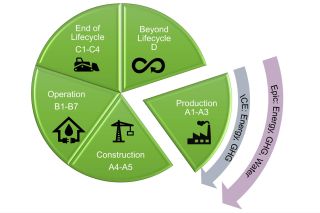
www.buildingsandcities.org/insights/commentaries/convergence-research.html
Why Convergence Research is Needed

Challenges ahead: addressing the complex issues of building performance, public safety, climate change and socio-ecological value
Several systemic failures have occurred across multiple aspects of the built environment in many parts of the world. Brian Meacham (Crux Consulting) explores what can be done to improve this situation. A need to reframe buildings and the built environment as a socio-ecological-technical system means applying systemic thinking and integration across disciplinary boundaries in research, design, construction and regulation.
Buildings and the built environment are complex systems
Most buildings today are complex - even what we might consider simple buildings. Traditional materials and methods of construction have been overtaken by highly engineered products and systems, which often focus on only a single specific performance requirement, such as thermal efficiency, to the detriment of other important performance requirements, such as fire safety. Skilled designers, engineers and craftspeople, who used to understand the holistic performance of buildings and how to achieve multiple performance requirements simultaneously, have largely been replaced by experts with knowledge of their specific area, but not of how buildings function as a system. Building regulatory systems have not kept pace with material and technology changes, meaning building performance and public safety are not being appropriately validated and accountability is harder to enforce. Much of this is driven by well-meaning policy directives, e.g. energy sustainability, housing affordability, and facilitation of trade, but more consideration of the potential for unintended consequences is needed.
The net result has been the introduction of new technologies, systems and approaches, often without understanding the holistic performance of buildings as systems, or what failure might mean for society, both at a building level and more broadly at a community or societal level. Inevitably, problems have manifest, for example the 'leaky building' situation in New Zealand, which cost the country billions of NZ dollars (PWC 2009); the Grenfell Tower fire, which resulted in numerous deaths and has had a significant impact on the UK society and construction sector (Grenfell Tower Public Inquiry 2017-2024); and arguably, the numerous communities around the world which have suffered greatly due to climate change induced hazards, from flooding to wildfire, which has cost USD100s of billions annually (e.g. Newman & Noy 2023). Impacts are most felt by vulnerable populations who typically possess neither the resources to mitigate risks nor the political voice to make themselves heard.
A major part of the problem is that the built environment is a complex sociotechnical system (STS), or perhaps more aptly, a socio-ecological-technical system (SETS) (e.g. Moffatt & Kohler 2008). However, our current approach to regulatory structures, to the development and introduction of technology, to education and training of actors in the system, to the research that underpins it all, largely ignores the STS/SETS nature of the problem. Instead of taking a holistic systems approach, the current way of doing things reflects the generation of knowledge through a collection of unconnected, individual disciplinary silos, which focus on diverse and specific parts of the problem. It is expected that someone else will have the responsibility to make sure everything works together as a system when implemented, or else it is not considered at all. Governments and markets follow the same, siloed approach, meaning where the building regulatory system works, this is more by chance than by implementation of appropriately research-supported systems approaches.
To improve the situation, first, we need to accept that buildings are complex STS, and urban spaces are complex SETS, meaning the built environment more broadly is a complex system of systems. STS theory and concepts emerged from studies of organizations and the roles of social and technological components, and the realization that they are integrally linked (Emery 1959; Trist & Murray 1993). STS theory points to the need to consider the interactions of organizations, institutions, actors, and technology in the proper functioning of organizations and systems. Buildings as STS is not a new concept (du Plessis & Cole 2011), with research in this area including energy performance in buildings (e.g. Lachhab et al. 2017; Lowe et al. 2017), fire performance of buildings (e.g. Meacham 2022), and building regulatory systems (e.g. Meacham & van Straalen 2017).
SES theory and concepts emerged from the observation that humans are part of the ecological system, and that the delineation between social systems and natural systems is arbitrary and artificial (Berkes & Folke, 1998). As with STS, this is not a new concept, and there are many definitions of SETS (e.g. Ahlborg et al. 2019; McPhearson et al. 2023; Chester et al. 2023) and the literature is extensive. In particular, the SETS framework described by McPhearson et al. (2023) explicitly acknowledges the interactions and interdependencies among social-cultural-economic-governance systems (social), climate-biophysical-ecological systems (ecological), and technological-engineered-infrastructural systems (i.e. the built or technological environment).
Overcoming the silo'd approach
While pockets of research on buildings as STS exist, and SETS recognizes the role of buildings and regulations within the system, arguably much of the research conducted on the built environment remains siloed, often lacking the STS/SETS perspective. This can be seen in funding opportunities, such as from the UK Research and Innovation, built environment area, in which all funding opportunities are in discrete areas, with seemingly no opportunity for consideration of buildings / built environment as STS/SETS (UKRI 2024). Such discipline-focused silos, coupled with university operational constraints built around such funding schemes (Cole 2024), can disincentivize researchers from taking steps to explore problems more holistically. To achieve greater penetration and impact, all research for the built environment needs to shift more significantly to STS/SETS frameworks. Fundamental to facilitating this is a focus on Convergence Research.
Convergence Research (CR) is also not a new concept. Over the past decade, it has increasingly gained prominence as a research, development, and innovation strategy to address grand societal challenges (Sundstrum et al. 2023; Gajary et al. 2024). A significant aim of CR is to emphasize the integration of knowledge across disciplinary boundaries, transcending multidisciplinary collaboration to obtain greater benefits from intellectual cross-pollination. As such, CR is itself a systems approach.
The US National Science Foundation (NSF) refers to CR as a means for solving vexing research problems, in particular, complex problems focusing on societal needs or deep scientific challenges, noting that it entails integrating knowledge, methods, and expertise from different disciplines and developing novel paradigms that catalyze scientific discovery and innovation (NSF 2024). The NSF notes that:
'a distinct characteristic of convergence research, in contrast to other forms of multidisciplinary research, is that from the inception, the convergence paradigm intentionally brings together intellectually diverse researchers and stakeholders to frame the research questions, adopt common frameworks for addressing them, and create and implement innovative scientific approaches for their solution.'
Implementing convergence research and thinking
The CR approach is actively promoted by the NSF, which has a dedicated funding area for supporting CR efforts (NSF 2024). CR has been undertaken in response to several types of complex problems, from brain science (Petersen et al. 2021) to graduate education for sustainable urban systems science (Lobo et al. 2021). As Sundstrom et al. (2023b) note, 'problems that require a convergence approach are those that involve nonlinearity, unpredictability, and irreducible uncertainty in system behavior and dynamics, all of which are heightened when there is tight coupling between multiple complex systems' which includes 'systems where social, ecological, and economic elements are strongly interconnected and codependent'. Buildings as STS and the built environment as SETS sit clearly within this realm.
While CR has been noted as being important within Europe (Science Europe 2014), it does not seem to have been widely adopted to date. The European Commission seems to be more focused on expanding international collaboration than on facilitating CR (EU Parliament Briefing 2023). This creates challenges for research teams looking to engage in CR, as funders may not understand the benefits and be hesitant to take the risk. Trying to organize convergence research around a specific and predefined problem becomes uncertain simply by bringing multiple disciplines into one room, for example, since the definition of the problem itself will inevitably change due to the broadening of perspectives that occurs as a result of collectively working on a shared problem (Sundstrom et al. 2023). This uncertainty in being able to well-define a problem and expected outcomes could potentially make funders wary of investing in CR approaches.
However, in order to adequately frame and understand the complex systems-of-systems that is the built environment, research needs to have intellectual and stakeholder diversity that defines CR, and the ability for new theories and approaches to emerge. This means more than just responding to research funding opportunities with multidisciplinary teams, from multiple institutions, to tick boxes on an application. It means identifying and engaging with researchers who are willing to step out of their disciplinary box, listen to and learn from others with different expertise, worldviews, and theoretical bases, and listen to, learn from, and work with the diversity of users of the built environment, who are ultimately the user of the research outcomes. It means doing this from the start - at the formulation of the research problem statement, before disciplinary biases become entrenched - working together to create a common vocabulary and agreed theoretical bases from the divergent approaches - to establish the foundation for moving forward in a convergent manner.
This will not be easy. Existing funding mechanisms, discipline-specific research approaches, and operational constraints may be difficult to overcome, especially in the beginning. However, the current approach is arguably failing to deliver holistic, well-performing solutions for the built environment that are adequately considering unintended consequences. If STS/SETS approaches, and systems thinking more broadly are not applied to research, design and construction of the built environment, we will miss many opportunities, and continue to see losses that we could otherwise have considered and presumably addressed along the way.
References
Ahlborg, H., Ruiz-Mercado, I., Molander, S. & Masera, O. (2019). Bringing technology into social-ecological systems research-motivations for a socio-technical-ecological systems approach. Sustainability 11(7), 2009. https://doi.org/10.3390/su11072009
Berkes, F. & Folke, C, (eds.). (1998). Linking Social and Ecological Systems: Management Practices and Social Mechanisms for Building Resilience. Cambridge University Press.
Chester, M.V., Miller, T.R., Muñoz-Erickson, T.A. et al. (2023). Sensemaking for entangled urban social, ecological, and technological systems in the Anthropocene. npj Urban Sustainability, 3, 39. https://doi.org/10.1038/s42949-023-00120-1
Cole, R.J. (2024). Research in a rapidly changing and increasingly uncertain world. Buildings & Cities. https://www.buildingsandcities.org/insights/commentaries/research-changing-uncertain-world.html
du Plessis, C. & Cole, R.J. (2011). Motivating change: shifting the paradigm. Building Research & Information, 39(5), 436-449. https://doi.org/10.1080/09613218.2011.582697
Emery, F. E. (1959). Some characteristics of socio-technical systems, Tavistock Document 527. London: Tavistock Institute.
EU Parliament Briefing (2023). The EU's global approach to research and innovation, EPRS | European Parliamentary Research Service, PE 730.550. https://www.europarl.europa.eu/RegData/etudes/BRIE/2022/733550/EPRS_BRI(2022)733550_EN.pdf
Gajary, L.C., Misra, S., Desai, A. et al. (2024). Convergence research as a 'system-of-systems': a framework and research agenda. Minerva, 62, 253-286. https://doi.org/10.1007/s11024-023-09503-1
Grenfell Tower Public Inquiry. (2017-2024). https://www.grenfelltowerinquiry.org.uk/
Lachhab, F., Bakhouya, M., Ouladsine, R., Essaaidi, M. (2017). Energy-efficient buildings as complex socio-technical systems: approaches and challenges. In: Nemiche, M. & Essaaidi, M. (eds) Advances in Complex Societal, Environmental and Engineered Systems. Nonlinear Systems and Complexity, vol 18. Springer, Cham. https://doi-org.ludwig.lub.lu.se/10.1007/978-3-319-46164-9_12
Lobo, J., Alberti, M., Allen-Dumas, M. et al. (2021). A convergence research perspective on graduate education for sustainable urban systems science. npj Urban Sustainability, 1, 39. https://doi.org/10.1038/s42949-021-00044-8
Lowe, R., Chiu, L.F. & Oreszczyn, T. (2017). Socio-technical case study method in building performance evaluation. Building Research & Information, 46(5), 469-484. https://doi.org/10.1080/09613218.2017.1361275
McPhearson, T., Cook, E., Berbés-Blázquez, M., Cheng, C., Grimm, N., Andersson, E., Barbosa, O., Chandler, D., Chang, H., Chester, M., Childers, D., Elser, S., Frantzeskaki, N., Grabowski, Z., Groffman, P., Hale, R., Iwaniec, D., Kabisch, N., Kennedy, C., Markolf, S., Matsler, A., McPhillips, L., Miller, T., Muñoz-Erickson, T., Rosi, E., Troxler, T. (2022). A social-ecological-technological systems framework for urban ecosystem services. One Earth. http://dx.doi.org/10.1016/j.oneear.2022.04.007
Meacham, B. J. & van Straalen, Ij. J. (2017). A socio-technical system framework for risk-informed performance-based building regulation. Building Research & Information, 46(4), 444-462. https://doi.org/10.1080/09613218.2017.1299525
Meacham, B.J. (2022). A sociotechnical systems framing for performance-based design for fire safety. Fire Technology, 58, 1137-1167. https://doi.org/10.1007/s10694-022-01219-0
Moffatt, S. & Kohler, N. (2008). Conceptualizing the built environment as a social-ecological system. Building Research & Information, 36(3), 248-268. https://doi.org/10.1080/09613210801928131
Newman, R. & Noy, I. (2023). The global costs of extreme weather that are attributable to climate change. Nature Communication, 14, 6103. https://doi.org/10.1038/s41467-023-41888-1
NSF (2024). Growing convergence research. https://new.nsf.gov/funding/opportunities/gcr-growing-convergence-research
Petersen, A.M., Ahmed, M.E. & Pavlidis, I. (2021). Grand challenges and emergent modes of convergence science. Humanities & Social Sciences Communication, 8, 194. https://doi.org/10.1057/s41599-021-00869-9
PWC - PriceWaterhouseCoopers. (2009). Weathertightness - Estimating the Cost. https://www.interest.co.nz/sites/default/files/PWC-leaky%20homes%20report.pdf
Science Europe. (2014). Physical, chemical and mathematical sciences committee workshop on convergence of disciplines. Brussels, 18-19 September 2014, https://scienceeurope.org/media/u0ycrqkz/workshop_report_convergence_final.pdf
Sundstrom, S.M., Angeler, D.G., Bell, J., Hayes, M., Hodbod, J., Jalalzadeh-Fard, B., Mahmood, R., VanWormer, E. & Allen, C.R. (2023b). Panarchy theory for convergence. Sustainability Science, 18: 1667-1682. http://dx.doi.org/10.1007/s11625-023-01299-z
Sundstrom, S.M., Angeler, D.G., Ernakovich, J.G., García, J.H., Hamm, J.A., Huntington, O., Allen, C.R. (2023). The emergence of convergence. Elementa: Science of the Anthropocene, 11(1). https://doi.org/10.1525/elementa.2022.00128
Trist, E. & Murray, H. (1993). The Social Engagement of Social Science, Volume 2: A Tavistock Anthology-The Socio-Technical Perspective. University of Pennsylvania Press.
UKRI. (2024). Areas of investment and support: built environment. UK Research and Innovation. https://www.ukri.org/what-we-do/browse-our-areas-of-investment-and-support/built-environment/
Latest Peer-Reviewed Journal Content
Youth engagement in urban living labs: tools, methods and pedagogies
N Charalambous, C Panayi, C Mady, T Augustinčić & D Berc
Co-creating urban transformation: a stakeholder analysis for Germany’s heat transition
P Heger, C Bieber, M Hendawy & A Shooshtari
Placemaking living lab: creating resilient social and spatial infrastructures
M Dodd, N Madabhushi & R Lees
Church pipe organs: historical tuning records as indoor environmental evidence
B Bingley, A Knight & Y Xing
A framework for 1.5°C-aligned GHG budgets in architecture
G Betti, I Spaar, D Bachmann, A Jerosch-Herold, E Kühner, R Yang, K Avhad & S Sinning
Net zero retrofit of the building stock [editorial]
D Godoy-Shimizu & P Steadman
Co-learning in living labs: nurturing civic agency and resilience
A Belfield
The importance of multi-roles and code-switching in living labs
H Noller & A Tarik
Researchers’ shifting roles in living labs for knowledge co-production
C-C Dobre & G Faldi
Increasing civic resilience in urban living labs: city authorities’ roles
E Alatalo, M Laine & M Kyrönviita
Co-curation as civic practice in community engagement
Z Li, M Sunikka-Blank, R Purohit & F Samuel
Preserving buildings: emission reductions from circular economy strategies in Austria
N Alaux, V Kulmer, J Vogel & A Passer
Urban living labs: relationality between institutions and local circularity
P Palo, M Adelfio, J Lundin & E Brandão
Living labs: epistemic modelling, temporariness and land value
J Clossick, T Khonsari & U Steven
Co-creating interventions to prevent mosquito-borne disease transmission in hospitals
O Sloan Wood, E Lupenza, D M Agnello, J B Knudsen, M Msellem, K L Schiøler & F Saleh
Circularity at the neighbourhood scale: co-creative living lab lessons
J Honsa, A Versele, T Van de Kerckhove & C Piccardo
Positive energy districts and energy communities: how living labs create value
E Malakhatka, O Shafqat, A Sandoff & L Thuvander
Built environment governance and professionalism: the end of laissez-faire (again)
S Foxell
Co-creating justice in housing energy transitions through energy living labs
D Ricci, C Leiwakabessy, S van Wieringen, P de Koning & T Konstantinou
HVAC characterisation of existing Canadian buildings for decarbonisation retrofit identification
J Adebisi & J J McArthur
Simulation and the building performance gap [editorial]
M Donn
Developing criteria for effective building-sector commitments in nationally determined contributions
P Graham, K McFarlane & M Taheri
Join Our Community

The most important part of any journal is our people – readers, authors, reviewers, editorial board members and editors. You are cordially invited to join our community by joining our mailing list. We send out occasional emails about the journal – calls for papers, special issues, events and more.
We will not share your email with third parties. Read more



Latest Commentaries
COP30 Report
Matti Kuittinen (Aalto University) reflects on his experience of attending the 2025 UN Conference of the Parties in Belém, Brazil. The roadmaps and commitments failed to deliver the objectives of the 2025 Paris Agreement. However, 2 countries - Japan and Senegal - announced they are creating roadmaps to decarbonise their buildings. An international group of government ministers put housing on the agenda - specifying the need for reduced carbon and energy use along with affordability, quality and climate resilience.
Building-Related Research: New Context, New Challenges
Raymond J. Cole (University of British Columbia) reflects on the key challenges raised in the 34 commissioned essays for Buildings & Cities 5th anniversary. Not only are key research issues identified, but the consequences of changing contexts for conducting research and tailoring its influence on society are highlighted as key areas of action.